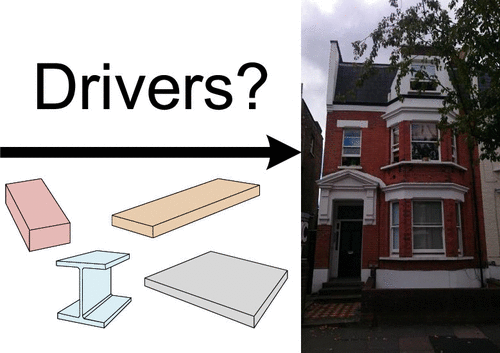当前位置:
X-MOL 学术
›
Environ. Sci. Technol.
›
论文详情
Our official English website, www.x-mol.net, welcomes your
feedback! (Note: you will need to create a separate account there.)
Log Mean Divisia Index Decomposition Analysis of the Demand for Building Materials: Application to Concrete, Dwellings, and the U.K.
Environmental Science & Technology ( IF 10.8 ) Pub Date : 2021-02-20 , DOI: 10.1021/acs.est.0c02387 He He 1, 2 , Rupert J. Myers 1, 2
Environmental Science & Technology ( IF 10.8 ) Pub Date : 2021-02-20 , DOI: 10.1021/acs.est.0c02387 He He 1, 2 , Rupert J. Myers 1, 2
Affiliation

|
Dwellings are material intensive products. To date, material use in dwellings has been investigated mainly using economic (exogenous) or dwelling (endogenous) drivers, with few studies comprehensively combining both. For the first time, we identify a comprehensive set of such drivers of demand for building materials and analyze them using the logarithmic mean divisia index (LMDI) method. We combine the LMDI method, the concept of dynamic material flow analysis, and physical and monetary flows to decompose the demand for building materials into the following six effects: material intensity, floor area shape, dwelling type, dwelling intensity, economic output, and population. We analyze these six effects on demand for concrete in new dwellings in the U.K. from 1951 to 2014, classified into six dwelling types and four subregions. Of these six effects, the material intensity effect is the most important, overall contributing to increasing concrete demand by +79 Mt from 1950 to 2014, while the dwelling intensity effect plays an opposite role, overall reducing concrete demand from 1950 to 2014 by −56 Mt. The economic output effect is also significant (+38 Mt from 1950 to 2014). A comparative analysis of the six effects in the four U.K. nations reveals that most of the effects arise from England, while the other nations have minor effects due to their smaller populations. Our results show that changes to the demand for concrete in the U.K. fluctuate and have mainly remained between ±30 Mt year–2 from 1950 to 2014, and thus the inflows of concrete into the in-use stock of dwellings have experienced neither entirely increasing or decreasing trends during this period. This study contributes to understanding changes in resource demand due to social, economic, and technological factors and thus improves the capability to reliably and quantitatively model the use of materials in the built environment.
中文翻译:

对建筑材料需求的对数平均Divisia指数分解分析:在混凝土,住宅和英国的应用
住宅是材料密集型产品。迄今为止,已经主要使用经济的(外生的)或住宅的(内生的)驱动因素研究了住宅中的材料使用,很少有研究将两者结合起来。我们首次确定了一套全面的此类建筑材料需求驱动因素,并使用对数平均除数指数(LMDI)方法对其进行了分析。我们将LMDI方法,动态物料流分析的概念以及实物和货币流相结合,将对建筑材料的需求分解为以下六个影响:材料强度,建筑面积形状,居住类型,居住强度,经济产出和人口。我们分析了这六种对英国1951年至2014年新住宅中混凝土需求的影响,分为六类住宅和四个分区。在这六个效果中,材料强度效应是最重要的,从1950年到2014年总体上使混凝土需求增加了+79 Mt,而住宅强度效应起相反的作用,从1950年到2014年总体使混凝土需求减少了-56Mt。经济产出效应也很显着(从1950年到2014年增加了38 Mt)。对英国四个国家的六个影响的比较分析表明,大多数影响来自英格兰,而其他国家由于人口较少而影响较小。我们的结果表明,英国对混凝土需求的变化是波动的,并且主要保持在±30 Mt年之间 从1950年到2014年,混凝土需求总体下降了-56吨。经济产出效应也很显着(从1950年到2014年增加了38 Mt)。对英国四个国家的六个影响的比较分析表明,大多数影响来自英格兰,而其他国家由于人口较少而影响较小。我们的结果表明,英国对混凝土需求的变化是波动的,并且主要保持在±30 Mt年之间 从1950年到2014年,混凝土需求总体下降了-56吨。经济产出效应也很显着(从1950年到2014年增加了38 Mt)。对英国四个国家的六个影响的比较分析表明,大多数影响来自英格兰,而其他国家由于人口较少而影响较小。我们的结果表明,英国对混凝土需求的变化是波动的,并且主要保持在±30 Mt年之间从1950年到2014年,这一比例为–2,因此在此期间,混凝土流入住宅使用存量的变化既没有完全增加也没有减少的趋势。这项研究有助于理解由于社会,经济和技术因素引起的资源需求变化,从而提高了在建筑环境中可靠,定量地建模材料使用的能力。
更新日期:2021-03-02
中文翻译:

对建筑材料需求的对数平均Divisia指数分解分析:在混凝土,住宅和英国的应用
住宅是材料密集型产品。迄今为止,已经主要使用经济的(外生的)或住宅的(内生的)驱动因素研究了住宅中的材料使用,很少有研究将两者结合起来。我们首次确定了一套全面的此类建筑材料需求驱动因素,并使用对数平均除数指数(LMDI)方法对其进行了分析。我们将LMDI方法,动态物料流分析的概念以及实物和货币流相结合,将对建筑材料的需求分解为以下六个影响:材料强度,建筑面积形状,居住类型,居住强度,经济产出和人口。我们分析了这六种对英国1951年至2014年新住宅中混凝土需求的影响,分为六类住宅和四个分区。在这六个效果中,材料强度效应是最重要的,从1950年到2014年总体上使混凝土需求增加了+79 Mt,而住宅强度效应起相反的作用,从1950年到2014年总体使混凝土需求减少了-56Mt。经济产出效应也很显着(从1950年到2014年增加了38 Mt)。对英国四个国家的六个影响的比较分析表明,大多数影响来自英格兰,而其他国家由于人口较少而影响较小。我们的结果表明,英国对混凝土需求的变化是波动的,并且主要保持在±30 Mt年之间 从1950年到2014年,混凝土需求总体下降了-56吨。经济产出效应也很显着(从1950年到2014年增加了38 Mt)。对英国四个国家的六个影响的比较分析表明,大多数影响来自英格兰,而其他国家由于人口较少而影响较小。我们的结果表明,英国对混凝土需求的变化是波动的,并且主要保持在±30 Mt年之间 从1950年到2014年,混凝土需求总体下降了-56吨。经济产出效应也很显着(从1950年到2014年增加了38 Mt)。对英国四个国家的六个影响的比较分析表明,大多数影响来自英格兰,而其他国家由于人口较少而影响较小。我们的结果表明,英国对混凝土需求的变化是波动的,并且主要保持在±30 Mt年之间从1950年到2014年,这一比例为–2,因此在此期间,混凝土流入住宅使用存量的变化既没有完全增加也没有减少的趋势。这项研究有助于理解由于社会,经济和技术因素引起的资源需求变化,从而提高了在建筑环境中可靠,定量地建模材料使用的能力。











































 京公网安备 11010802027423号
京公网安备 11010802027423号